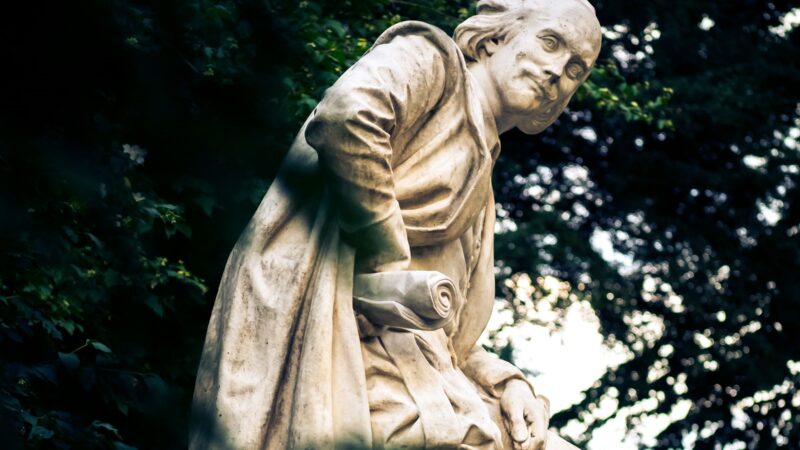Mania by Lionel Shriver (Book Review)
Lionel Shriver’s latest novel, Mania, imagines a world in which the concept of intelligence has become taboo. ‘Dumb’, ‘stupid’, ‘moronic’ and every other synonym that might adequately describe the mentally deficient have become unspeakable terms of offence, while IQ tests and entrance exams alike are outlawed on the grounds of elitism. Idiots are not a protected class, however, because the prevailing ideology posits that idiots simply don’t exist. In this egalitarian utopia, everyone is equally smart. To suggest anything to the contrary is to commit a hate crime punishable by professional ruin and social ostracism.
If this all sounds familiar, it’s because Mania is a pointed parody of the socio-political logic of what Shriver, in a recent piece for UnHerd, described as the ‘collective crazes’ of the last decade: transgenderism, #MeToo, Covid lockdowns and Black Lives Matter. Her journalism has tackled each of these movements individually and collectively, but Mania is her first work of fiction to deal with the twin forces of political correctness and cancel culture head on. It’s perhaps worth pointing out that her recent novel, The Motion of the Body Through Space, featured as part of its subplot a diversity hire whose incompetence leads to the breakdown of the transport system in Hudson, New York – which landed Shriver in hot water during a promotional tour of the book. But critics will struggle to condemn Mania as offensive. For while the novel is implicitly critical of radical progressive politics, the Mental Parity movement is a squarely fictional creation. Even in the fragile political climate of 2024, the foolish remain fair game as an object of ridicule.
Mania’s characters are recognisable archetypes of any cowed and paranoid society. Plucky, witty and dangerously opinionated, Pearson Converse is one of Shriver’s most autobiographical protagonists, mirroring everything from the author’s overbearingly religious upbringing to the rebellious mentality it imprinted on her. Her defiance in the face of the Mental Parity movement makes Pearson a black sheep in polite society, but stems from a desire to protect her two eldest children, a pair of prodigies who in any other age would have a bright future lined up for them. It is the third child, Lucy, who, having grown up in an age in which Mental Parity has become the mainstream, constitutes an unlikely antagonist, blackmailing her mother and policing her language and behaviour. It is telling that Lucy’s ideological and cognitive equivalents throughout Mania are the teachers, politicians and television presenters, and that perhaps the only other thing they have in common is an unmerited power over those who dare to speak out.
But the real conflict that rages like a dynamo from Mania’s first pages to its dramatic conclusion is more nuanced, more complicated than a simple black-and-white battle between critical thinking Davids and knuckle-dragging Goliaths. Despite Pearson’s career as a university professor, the book focuses less on the shadowy cabal of academics pulling the strings of Mental Parity than on those who are complicit with the regime, or merely undecided. It is complacency that drives a wedge between Pearson and her comparatively apolitical husband, Wade, whom she accuses of ‘sit[ting] this whole thing out on the sidelines, watching, or declining to watch.’ Far more sinister is the character of Emory, Pearson’s lifelong pal, whose position on the whole thing is not neutral but ambiguous. What makes Emory particularly villainous is not that she is a believer, but that she is a non-believer, prepared to manipulate the burgeoning climate of paranoia for her own gain, advancing her career as a talkshow host by producing disingenuous op-eds on microaggressions or thought crimes and thereby embodying, by Pearson’s account, ‘the intelligent face of stupid’.
As Emory rides the coattails of this movement, Pearson’s own career – not to mention her family life and reputation – begins to spiral. Her first brush-in with the tyrannical power of Mental Parity comes when she assigns her literature class a novel that the self-anointed censors have exorcised from the Western canon. The scene is reminiscent of the opening of last year’s American Fiction, in which Monk, a black professor, writes on the class blackboard the name of a Flannery O’Connor story, only for a blue-haired white girl to object that she finds the title – ‘The Artificial Nigger’ – offensive. Monk is laid off from his job as a consequence. Pearson doesn’t quite lose her job for assigning Dostoevsky’s The Idiot to her class, but the stunt earns her the resentment of colleagues and students both, as well as a stern warning. What leads to her eventual dismissal is her later deployment of the word ‘retard’ during a tirade in class. Typically, the scene is filmed by every student in the class and uploaded to the internet.
Pearson is not even safe within her own home, which she considers a sanctuary of normality – only for Lucy to report her to social services. As a result, Pearson is required to take a six-week Cerebral Acceptance and Semantic Sensitivity class, with the aim of weeding out elitist language from her vocabulary:
Considering that ‘grasp’ could convey mastery some people lacked, we should instead ‘grip’ or ‘seize’ our coffee mugs. ‘Command’ could also mean an unjustifiable sense of intellectual dominion, so in a position of authority we should issue an ‘edict’ or ‘direction’. Admiring classifications such as ‘savvy’, ‘scholarly,’ and ‘erudite’ couldn’t help but imply the existence of benighted characters who exhibited none of these qualities, so if we were hell-bent on acclaiming colleagues, we should keep to wholesome, simple – sorry, uncomplicated – compliments such as ‘I like you’ or ‘That is good.’
If the attempt to jettison every contaminated word in the English language seems overkill, recall the institutional scramble only a couple of years ago, in which colleges across America issued ‘harmful language’ lists to students, singling out problematic obscenities such as ‘field’, ‘blackboard’, ‘straight’, ‘American’ and – you guessed it – ‘stupid’. Shriver herself conducted a highly entertaining takedown of this phenomenon for the Spectator. One gets the sense that this sterile dumbing down of the English language is what irks her the most, since the straitjacket of minimally offensive newspeak could not be further from the vibrancy and elasticity of the author’s own style. The unfortunate fact for her enemies is that Shriver is one of the most capable writers around. Her insights are profound and her prose is lucid, every sentence an immaculately crafted marvel of colloquial lyricism.
There is a disconcerting familiarity to the events of Mania, which echo some of the more maddening episodes of the last few years. From Sherlock to Columbo, films and TV shows which are seen to promote the notion of ‘cleverness’ are taken off air and removed from circulation. And a campaign to rename the city of Voltaire gains traction, since the views espoused by the author of Candide are no longer in step with those of its residents.
In a conversational aside we learn that the rest of the world thinks the West has lost its marbles. It’s clear that Shriver has borrowed liberally from the events and controversies that have defined the zeitgeist, but Mental Parity is a creation all her own. Indeed, the titular mania is such a powerful force that it has the effect of sidelining all other social justice movements. Anders Breivik receives public sympathy after murdering 69 members of the Norwegian Workers’ Youth League for exhibiting ‘less than spectacular intelligence’. Not only is the concept of Islamophobia absent from political discourse, but Western society’s fascination with race itself has become blessedly passé – to President Obama’s detriment. ‘Nobody gives a crap anymore about his being a black president,’ Emory states, when the Mental Parity movement is still in its infancy. ‘He’s a know-it-all president. It’s death.’ His replacement is the ‘impressively unimpressive’ Joe Biden, acclaimed for his ‘delectably leaden’ speaking style. But when even the doddering ineptitude of a potentially demented president proves insufficient to satisfy voters, the Democrats find a new champion in the form of Donald Trump. Across the pond, meanwhile, the UK’s decision to leave the EU becomes a win for progressivism, given the tendency of many Remainers to demonise Brexiteers as stupid.
The good thing is that this imagined mania is so much worse – and therefore more entertaining – than any of the real manias currently afflicting the Western world. Thanks to the Mental Parity movement, food produced in the US is no longer safe to eat, nearly all fatalities in the armed forces are caused by friendly fire and a brain drain has left America stunted, handing China and Russia the keys to world domination.
But while Mania is funny, razor-sharp and extremely readable, it’s also eerily realistic. For the seeds of Mental Parity may already have been sewn, and not just in the soil surrounding the R word. Universities are increasingly eschewing standardised examinations, while columnists wage war against the very idea of meritocracy. What’s more, in a further affront to the English language, last month it was announced that a new version of Scrabble was being released with simplified rules, in order to make the game ‘more accessible for anyone who finds word games intimidating’. If Lionel Shriver’s alternative history becomes the actual future, this fine novel will be the first for the chopping block. Read it while you still can.










